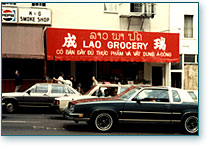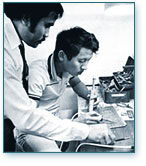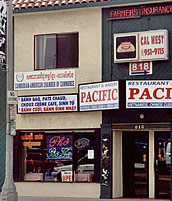 Business Owners Business Owners
By saving money or pooling resources among family and friends, some Southeast Asian Americans have opened up small businesses that provide goods and services to co-ethnics. Professionals provide services in the real estate, insurance, medical, legal, and banking professions. Entrepreneurs have established markets, restaurants, cafés, and bakeries as well as clothing, furniture, herbal, jewelry, music, and auto shops. Some are using their homeland connections to operate travel, communication, import/export, and consulting businesses. In urban areas with commercial ethnic districts, the competition can be fierce; some business owners are highly successful, while others barely make a profit.
Unfortunately, co-ethnic gangsters have preyed on business owners by extorting money in return for “protecting” their commercial neighborhoods. To avoid these problems, some Southeast Asians have instead established businesses in mainstream communities and rely on non-Asian customers. For example, small doughnut shops have provided Cambodians and ethnic Chinese Cambodians with a business niche, especially in California, where they own about half of such shops, even though doughnuts were not part of any ethnic diet. Southeast Asian businesses infuse millions of dollars of tax revenue into local economies and have revitalized declining neighborhoods.
 Manual Laborers and Service Sector Workers Manual Laborers and Service Sector Workers
Other Southeast Asians have found various means of survival in manual labor. In some cases, the employees own these enterprises. The many refugees and immigrants who came from rural areas in their homelands have found economic subsistence in agricultural production. Farmers grow Asian vegetables, fruits, and flowers that they sell to ethnic markets and restaurants or at local farmers markets, especially in Western states. Given that their homeland locations were generally near the ocean or a waterway, many were involved with the fishing industry and re-established themselves in this profession in the U.S., particularly in the South. Some have found employment in manufacturing jobs in small and large factories, such as the high tech assembly industry in California or beef and poultry meatpacking plants in the Midwest.
Continued on page 2 |
<< Back |
[1] 2 |
Next >> |
|


 Business Owners
Business Owners Manual Laborers and Service Sector Workers
Manual Laborers and Service Sector Workers